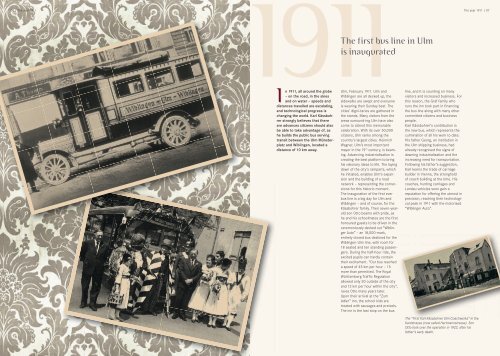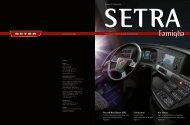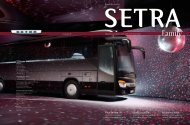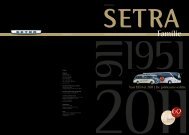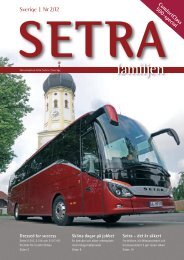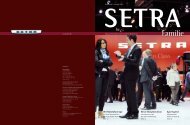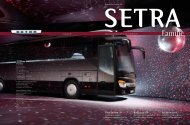Family - Setra
Family - Setra
Family - Setra
You also want an ePaper? Increase the reach of your titles
YUMPU automatically turns print PDFs into web optimized ePapers that Google loves.
06 | The year 1911<br />
1911<br />
The first bus line in Ulm<br />
is inaugurated<br />
The year 1911 | 07<br />
I<br />
n 1911, all around the globe<br />
– on the road, in the skies<br />
and on water – speeds and<br />
distances travelled are escalating,<br />
and technological progress is<br />
changing the world. Karl Kässbohrer<br />
strongly believes that there<br />
are advances citizens should also<br />
be able to take advantage of, as<br />
he builds the public bus serving<br />
transit between the Ulm Münsterplatz<br />
and Wiblingen, located a<br />
distance of 10 km away.<br />
Ulm, February 1911. Ulm and<br />
Wiblingen are all decked up, the<br />
sidewalks are swept and everyone<br />
is wearing their Sunday best. The<br />
cities’ digni-taries are gathered in<br />
the stands. Many visitors from the<br />
areas surround-ing Ulm have also<br />
come to attend this memorable<br />
celebration. With its over 50,000<br />
citizens, Ulm ranks among the<br />
country’s largest cities. Heinrich<br />
Wagner, Ulm’s most important<br />
mayor in the 19 th century, is beaming.<br />
Advancing industrialisation is<br />
creating the best platform to bring<br />
his visionary ideas to life. The laying<br />
down of the city’s ramparts, which<br />
he initiated, enables Ulm’s expansion<br />
and the building of a road<br />
network – representing the cornerstone<br />
for this historic moment.<br />
The inauguration of the first ever<br />
bus line is a big day for Ulm and<br />
Wiblingen – and of course, for the<br />
Kässbohrer family. Their seven-yearold<br />
son Otto beams with pride, as<br />
he and his schoolmates are the first<br />
honoured guests to be driven in the<br />
ceremoniously decked out “Wiblinger<br />
Auto” – an 18,000-mark,<br />
entirely closed bus destined for the<br />
Wiblingen-Ulm line, with room for<br />
18 seated and ten standing passengers.<br />
During the half-hour ride, the<br />
excited pupils can hardly contain<br />
their excitement. “Our bus reached<br />
a speed of 45 km per hour – 15<br />
more than permitted. The Royal<br />
Württemberg Traffic Regulation<br />
allowed only 30 outside of the city<br />
and 12 km per hour within the city”,<br />
raves Otto many years later.<br />
Upon their arrival at the “Zum<br />
Adler” inn, the school kids are<br />
treated with sausages and pretzels.<br />
The inn is the last stop on the bus<br />
line, and it is counting on many<br />
visitors and increased business. For<br />
this reason, the Graf family who<br />
runs the inn took part in financing<br />
the bus line along with many other<br />
committed citizens and business<br />
people.<br />
Karl Kässbohrer’s contribution is<br />
the new bus, which represents the<br />
culmination of all his work to date.<br />
His father Georg, an institution in<br />
the Ulm shipping business, had<br />
already recognised the signs of<br />
dawning industrialisation and the<br />
increasing need for transportation.<br />
Following his father’s suggestion,<br />
Karl learns the trade of carriage<br />
builder in Vienna, the stronghold<br />
of coach building at the time. His<br />
coaches, hunting carriages and<br />
Landau vehicles soon gain a<br />
reputation for offering the utmost in<br />
precision, reaching their technological<br />
peak in 1911 with the motorised<br />
“Wiblinger Auto”.<br />
The “First Karl Kässbohrer Ulm Coachworks” in the<br />
Kantstrasse (now called Hartmannstrasse). Son<br />
Otto took over the operation in 1922, after his<br />
father’s early death.


